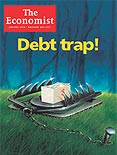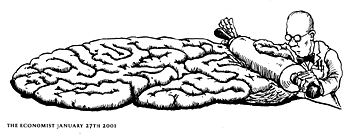|
|
||||||
Topology and neurology Navigating your mind Jan 25th 2001 | NEW ORLEANS From The Economist print edition Online edition from The Economist |
 |
YOUR neurologist would love to flatten your brain. Not physically, you will be glad to know, but mathematically. For, just as the exploration of the earth's surface (a sphere, more or less) required the creation of appropriate flat maps, so, too, does the exploration of the surface of the brain.
It is not that hard to convert a sphere into a plane, provided that you are clear about the compromises you are prepared to make. The Mercator projection, for example, preserves shapes and angular relationships at the expense of areas-so that the polar regions look far too large in relation to the equatorial ones. Flattening out the convoluted surface of the brain requires more compromises than that. But Monica Hurdal of Florida State University thinks that she has made them in an acceptable way. At the recent joint annual meetings of the American Mathematical Society and the Mathematical Association of America in New Orleans, she presented her work on "quasi-conformal maps of the human brain from circle packings".
Brains do most of their information-processing on the surface-or cortex, as it is known neurologically. So species that, in the course of evolution, have come to need more brain-power, have developed brains with creased, convoluted cortexes that pack more surface area into the same volume of skull. This makes it hard for researchers to see exactly which parts of the cortex are doing what, and how they are related to one another. So, although it is possible to put somebody into a brain scanner, set them a task, and see which bits of their cortex light up with activity, areas that look adjacent in an image produced by the scanner may, if they have a deep fold between them, actually be a long way apart.
That is where a map-a flattened version of the brain showing exactly where on its surface the activity is taking place-would come in handy. It would, for preference, be a projection that preserves shapes, like Mercator's. And this is indeed possible, according to Dr Hurdal, using a law of geometry known as the Riemann mapping theorem that was first enunciated in 1854.
This theorem says that every continuous surface can be turned into a special kind of flat map, called a conformal map. Such a map means that if you have two angles on the original surface, and one is twice as large as the other, the first angle will remain twice as large as the second even if the actual number of degrees in each angle changes. This is not quite as good as keeping every angle the same, as with Mercator's projection, but it is good enough for neurologists who want to steer between bits of the cortex.
To prove her point, Dr Hurdal showed her audience a map of part of the brain, called the cerebellum, of a hapless student who had been induced to undergo no fewer than 27 brain scans. The upshot of this scanning was a high-quality three-dimensional image, to a precision of one millimetre in each direction. This level of precision allowed her to distinguish precisely between the "white" matter of the brain's interior, and the "grey" matter of its cortex. The result was a network of 50,000 cortical points, each connected to its nearest neighbours by a line. Dr Hurdal thus ended up with a landscape, still convoluted, of triangles.
The hard part was flattening this network of triangles. But an older theorem, going back to the ancient Greeks, states that you can always draw three circles around the corners of a triangle so that each one just touches the other two. Since any two of these circles will also belong to a neighbouring triangle, if you have thousands of triangles in a flat plane, you can have a perfect packing of that plane by thousands of circles.
Unfortunately, the triangles that represent the surface of a brain are not in a flat plane, so the touching circles drawn in each of them will stick out. But there will still, according to the Riemann theorem, be a unique way to move all the points until they settle down with the circles into a well-packed plane. The result is, to a good approximation, a conformal map.
Navigation, however, also requires a reference grid. On the earth's surface, this is derived from two fixed points (the poles) and a line (the equator). In the cerebellum, the equivalents of these have to be bits of anatomy that can be recognised in everybody's version of the structure. Fortunately, although much about the cerebellum is mysterious, enough is known for such features to have been identified.
Once brain-navigation becomes routine (with luck, without the need for 27 separate scans), it will be possible to track changes in a brain over time. It will also be possible to compare the brain maps of individuals, even if everyone's cortex is folded slightly differently. And that should lead to some interesting voyages of neural discovery indeed.

|
Copyright © 1995-2001 The Economist Newspaper Group Ltd. All rights reserved.
|